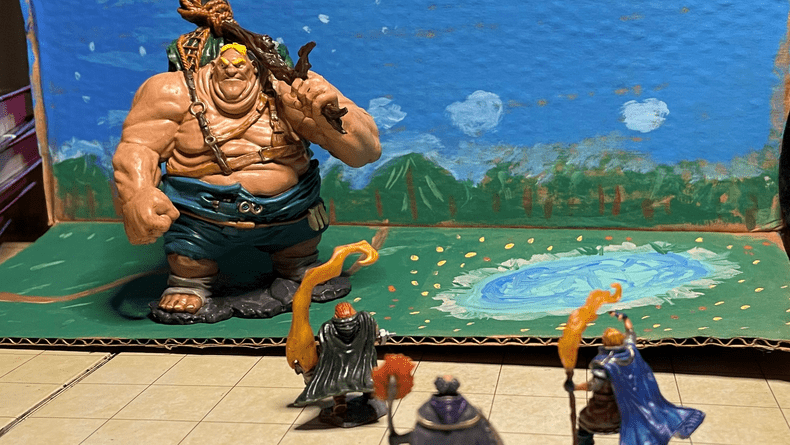Paralyzed
-
A paralyzed creature is incapacitated (see the condition) and can’t move or speak.
-
The creature automatically fails Strength and Dexterity saving throws. Attack rolls against the creature have advantage.
-
Any attack that hits the creature is a critical hit if the attacker is within 5 feet of the creature.
Paralyzed 5e
The paralyzed condition is one of the most powerful conditions in DnD 5e. It’s a defensive win in that it strips actions and movement from the target, while also netting significant offensive advantages for your whole party — especially melee characters.
I’ll cover how to cause paralysis, how to break out of it, the rules for the paralyzed condition, and tips for DMs who find the paralyzed condition too punishing for players (or whose players find it unfun — a common complaint in my experience).
How Does Paralyzed Work in 5e?
The Paralyzed condition causes a creature to be incapacitated (cannot take actions, bonus actions, or reactions), unable to move, automatically fail Strength and Dexterity saves, be attacked with advantage, and have attacks from within 5 feet to be automatic critical strikes (roll double damage dice).
It’s incredibly powerful and punishing, only beaten by the unconscious condition among 5e’s conditions that cause a creature to become incapacitated.
Conditions that incapacitate a creature and their extra effects:
| Condition | Can’t Move | Can’t Speak | Attacked With Advantage | Auto-Crit From Melee | Auto-Fail Str/Dex Saves | Unaware of Surroundings | Falls Prone |
|---|---|---|---|---|---|---|---|
| Stunned | X | * | X | X | |||
| Paralyzed | X | X | X | X | X | ||
| Unconscious | X | X | X | X | X | X | X |
| Petrified | X | X | X | X | X |
*Can speak only falteringly
What Are the Rules for Paralyzed in 5e?
The rules for Paralyzed in DnD 5e are as follows:
-
A paralyzed creature does not fall prone. While you might assume that being paralyzed causes you to fall, this is not in the rules, and therefore it doesn’t happen.
-
A creature who is paralyzed and prone will not be attacked with advantage or disadvantage from more than 5 feet away. As Jeremy Crawford confirms, “the effects of different conditions stack” and “advantage and disadvantage cancel each other out.”
-
A Rogue’s Evasion feature still functions while paralyzed. Technically, RAW is that Evasion (half damage from failed Dexterity saving throws) still works while a Rogue is paralyzed. However, Jeremy Crawford concedes that, RAI (rules as intended), being paralyzed negates the feature, so you’d still take half damage from a failed Dexterity saving throw (which is automatic while paralyzed).
Ultimately, this leaves it up to each individual DM to rule (I rule that paralyzed negates Evasion because it feels like common sense, but that’s just me).
-
Ranged attacks made from within 5 feet of a paralyzed creature aren’t made with disadvantage. Normally, making a ranged attack against a creature while a hostile creature is within 5 feet of you imposes disadvantage on the attack roll. However, this doesn’t apply if the hostile creature within 5 feet of you is incapacitated. (PHB 195).
So, as long as the paralyzed creature is the only hostile creature within 5 feet, of you, you do not have disadvantage on the attack roll. And if you’re attacking that creature from within 5 feet, the attack still has advantage (since disadvantage doesn’t apply, and therefore doesn’t cancel out your attack advantage granted from it being paralyzed).
-
A Paralyzed creature can still hold its breath. While this might seem counterintuitive, nothing in the rules for suffocation changes when a creature is paralyzed (it can hold its breath for a number of rounds equal to 1 + its Constitution modifier) (PHB 183). A DM is well within their rights to rule otherwise, though.
-
An Evocation Wizard’s Sculpt Spell ability can protect a Paralyzed ally. This subclass ability prevents a creature from taking damage from area-of-effect saving throw spells. Like Evasion, the RAW is a bit unclear, but since the Wizard is the one doing the sculpting (not the Paralyzed creature), I tend to rule that the Paralyzed ally nevertheless automatically succeeds on their saving throw and thus takes no damage (story-wise, the spell isn’t really touching them at all; it’s sculpted in such a way that it never affects them).
-
Spiritual Weapon does not automatically crit a paralyzed creature unless the caster is within 5 feet of the target as well. Spiritual Weapon is an attack made by the spellcaster; not the weapon itself. As such, the caster must be within 5 feet of the target to benefit from the “automatic critical” effect of the paralyzed condition.
-
A creature with Legendary Resistance can still use it while Paralyzed. Because Incapacitated only removes actions, bonus actions, and reactions; Legendary Resistance requires none of these things; it is an ability inherent in the monster that allows them to succeed on any saving throw they fail (even if the failure was automatic, as is the case with being Paralyzed and making a Strength or Dexterity saving throw).
The effects of different conditions stack.
Advantage and disadvantage cancel each other out. #DnD https://t.co/o85IGHFntS
— Jeremy Crawford (@JeremyECrawford) October 15, 2018
The Evasion feature refers to you dodging, but it doesn't explicitly require you to be mobile. RAI: being paralyzed negates the feature. RAW: being paralyzed has no effect on the feature. Either way, being paralyzed causes you to automatically fail a Dexterity saving throw. #DnD https://t.co/AWC3YmrmOr
— Jeremy Crawford (@JeremyECrawford) April 3, 2018
Paralyzed Spells 5e
There are only two spells that cause the Paralyzed condition in DnD 5e:
-
Hold Person. 2nd-level spell available to Bards, Clerics, Druids, Sorcerers, Warlocks, Wizards, Order Domain Clerics, Blood Domain Clerics, Circle of the Land (Arctic) Druids, Oath of Vengeance Paladins, Oath of Conquest Paladins, and Oath of Redemption Paladins. It only affects humanoid creatures. The creature must fail a Wisdom saving throw for it to affect them, and they can repeat this Wisdom saving throw at the end of their turns, ending the spell early on a success.
-
Hold Monster. 5th-level spell available to Bards, Sorcerers, Warlocks, Wizards, War Domain Clerics, Oath of Vengeance Paladins, Oath of Redemption Paladins, and Oath of Watchers Paladins. The creature must fail a Wisdom saving throw for it to affect them, and they can repeat this Wisdom saving throw at the end of their turns, ending the spell early on a success.
How to Remove the Paralyzed Condition in 5e
Here are a few ways to end the Paralyzed condition in DnD 5e:
-
Pass a saving throw. While the two Hold spells require a successful Wisdom save to avoid or break free from, many monster abilities require a Constitution saving throw (Beholder’s, Death Tyrant’s, and Spectator’s Paralyzing Ray ability, a Chuul’s or Carrion Crawler’s Tentacles ability, or a Ghast’s or Ghoul’s Claws ability, for instance). Wisdom saves also come up for some monster’s abilities that paralyze, like a Revenant’s Vengeful Glare ability or other, similar “glare” abilities that paralyze.
-
Lesser Restoration. 2nd-level spell available to Bards, Clerics, Druids, Paladins, Rangers, Artificers, Life Domain Clerics, Oath of Devotion Paladins, Celestial Warlocks, and Divine Soul Sorcerers. This spell removes the blinded, deafened, paralyzed, or poisoned conditions — paralyzed being by far the most potent of the bunch (although poisoned is far more common and longer-lasting).
-
Freedom of Movement. 4th-level spell available to Bards, Clerics, Druids, Rangers, Artificers, and many Druid and Paladin subclasses. This spell is a 1-hour buff that prevents a target from being paralyzed or restrained and it doesn’t require concentration to maintain, making it a great spell to pre-cast when you know you’re about to fight monsters that have abilities that can paralyze you.
However, note that, technically, this spell only works on “magical effects” (which most monster abilities are NOT, as per the Sage Advice Compendium (pg. 21 — Is the breath weapon of a dragon magical; answer: no).). However, most DMs and players find this ruling kind of silly (myself included), so I rule that Freedom of Movement prevents all Paralyzed effects, regardless of the source.
-
Power Word: Heal. 9th-level spell available to Bards and Clerics. Removes charmed, frightened, paralyzed, and stunned conditions. The target also regains all their hit points — the be-all and end-all of healing spells in DnD 5e.
-
Aura of Purity. 4th-level spell available to Clerics and Paladins. Gives allies within 30 feet has advantage on saving throws against being paralyzed, blinded, frightened, charmed, deafened, poisoned, and stunned.
-
Elixir of Health (DMG 168). Rare potion that removes paralyzed, blinded, deafened, and poisoned conditions from the drinker.
-
Elixir of Health (DMG 191). Rare ring that makes the wearer immune to being paralyzed or restrained.
-
Wand of Paralysis (DMG 209). 7-charge rare wand that allows you to spend 1 charge to gain advantage on a saving throw to avoid being paralyzed.
Items That Cause the Paralyzed Condition in 5e
A few items in DnD 5e can cause the Paralyzed condition:
-
Carrion Crawler Mucus (Contact Poison) (DMG 258). Forces a creature exposed to it (touches their exposed skin) to make a DC 13 Constitution saving throw or become paralyzed for 1 minute (repeat saves at the end of each of its turns, ending early on a success).
-
Rod of Lordly Might (DMG ). +3 legendary mace that allows you to force a creature you hit to pass a DC 17 Strength saving throw or be Paralyzed for 1 minute (repeat saves at the end of its turns) once per day.
-
Wand of Binding (DMG 209). 7-charge rare wand that allows you to cast Hold Monster (5 charges) and Hold Person (2 charges) (DC 17 for each).
-
Wand of Paralysis (DMG 211). 7-charge rare wand that allows you to force a creature with 60 feet to pass a DC 15 Constitution saving throw or be Paralyzed for 1 minute (repeat saves at the end of its turns). The wand regains 1d6 + 1 charges each day.
Paralyzed 5e DM Tips
It’s a popular opinion in the 5e community that the Paralyzed condition is unfun for players. It removes their entire turn in combat (or even more, if they continue to fail saving throws), and 5e is a system where a player likely has fewer than 10 turns in an entire session. Missing 10%+ of your turns just feels bad.
That’s why I recommend using it sparingly, especially at lower levels. At higher tiers of play (level ~8+), when monsters don’t play fair and players expect powerful effects to be part-and-parcel of any combat encounter, it’s a more acceptable condition to work into your combat encounters.
A good homebrew option for lower-leveled creatures that have Paralyzed effects is a lingering injury (deals extra damage each turn if they try to move, slows their movement, removes their bonus action/reaction, attack rolls against them have advantage, etc.). That way, the player still has agency, but they still suffer from a negative effect.

![Stunned 5e [DnD Condition Guide: How To Get Out Of Stuns, Spells That Stun, Creatures Immune To Stun] dungeons-and-dragons-party-vs-troll-minis](https://www.dndlounge.com/wp-content/uploads/2022/03/dungeons-and-dragons-party-vs-troll-minis-300x200.jpg)

![How to Get Advantage 5e [DnD Quick Guide] wereraven-minis-dnd-5e](https://www.dndlounge.com/wp-content/uploads/2023/04/wereraven-minis-dnd-5e-300x169.webp)
![When Do You Get Feats In 5e? [DnD Quick Guide] orcs-vs-party-dungeons-and-dragons](https://www.dndlounge.com/wp-content/uploads/2022/11/orcs-vs-party-dungeons-and-dragons-300x169.webp)
Great content! Thanks for publishing!
TYPO: Under the section: Items That Cause the Paralyzed Condition in 5e, you refer to the
3. Wand of Paralysis (DMG 209). 7-charge rare wand that allows you to cast Hold Monster (5 charges) and Hold Person (2 charges) (DC 17 for each).
It should be the Wand of Binding.
You correctly refer to the Wand of Paralysis in #4.
Thank you, just went and fixed that! Glad to hear you like the site 🙂